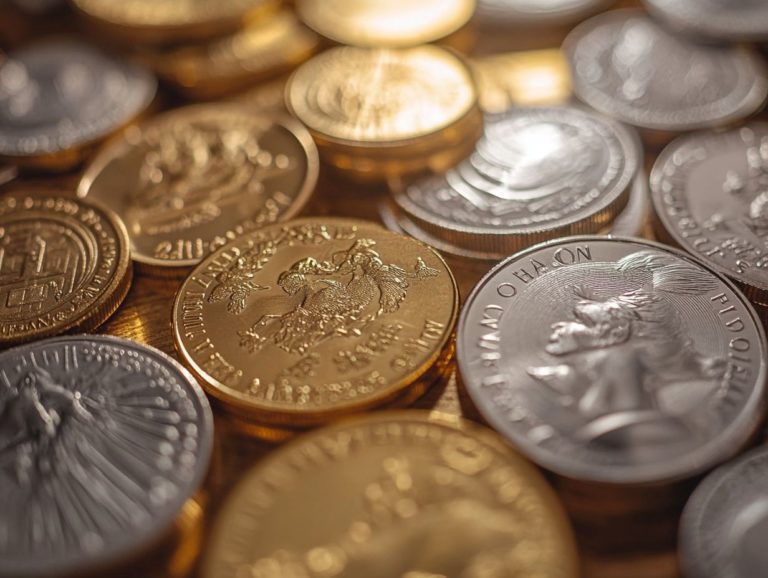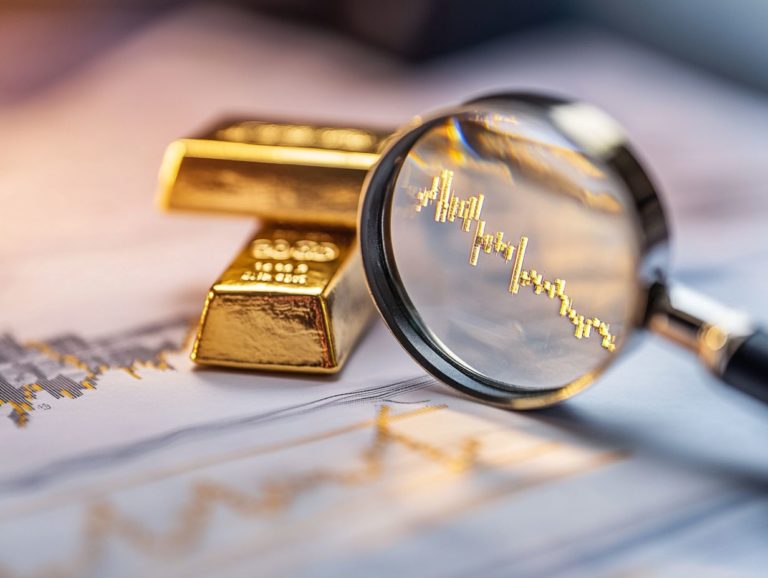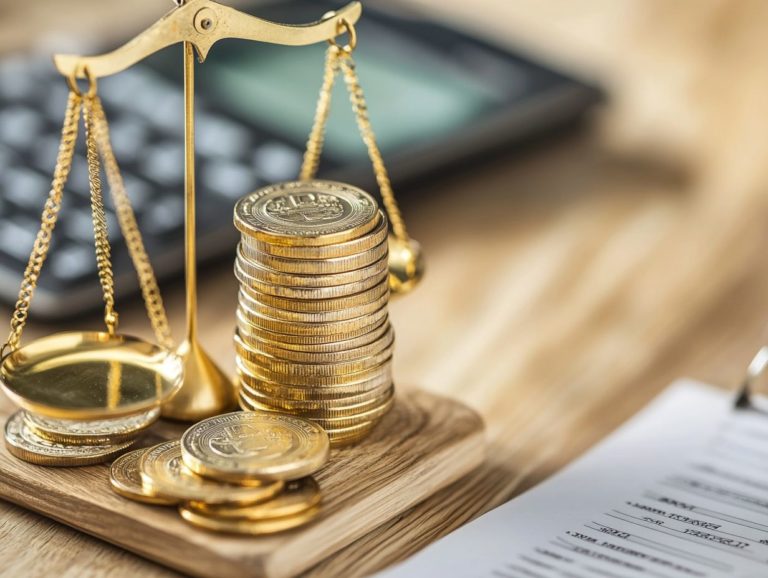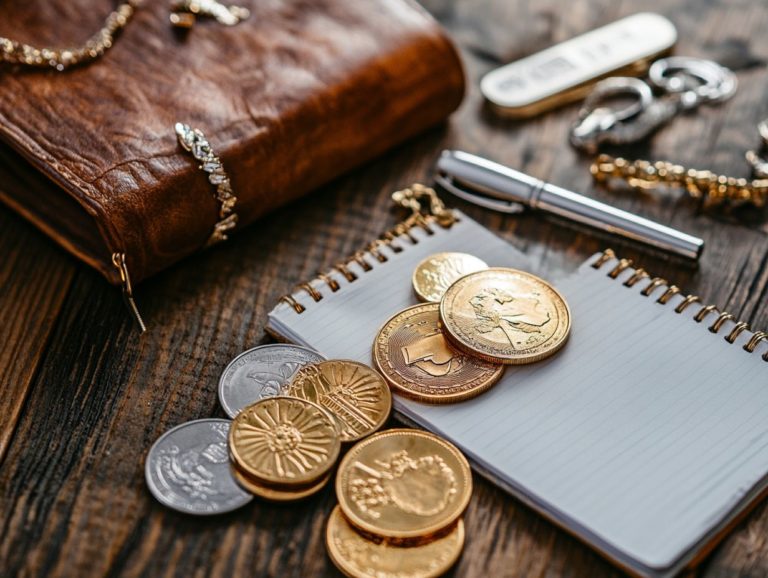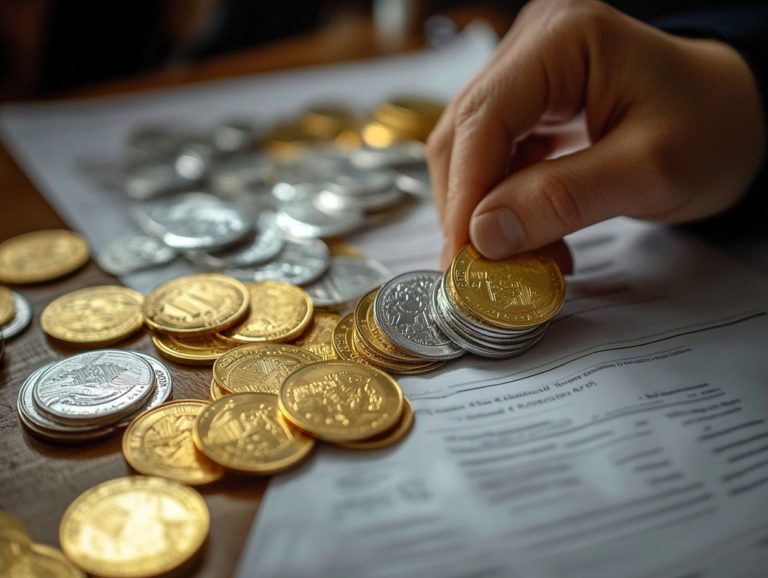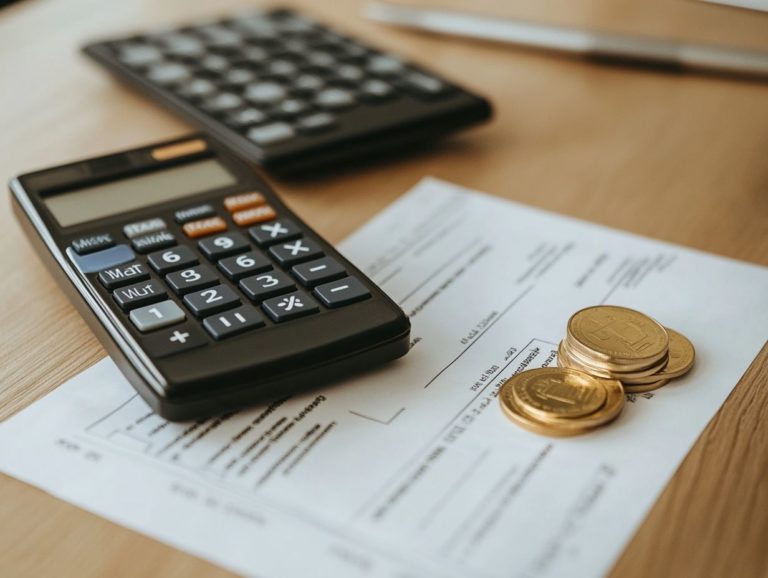How to Build a Precious Metals Portfolio?
Investing in precious metals presents an intelligent avenue for diversifying your portfolio and safeguarding your wealth against the erosive effects of inflation.
This article delves into the world of precious metals, illuminating their advantages and illustrating how they act as a reliable hedge during uncertain economic times.
You ll discover the primary types gold, silver, platinum, and palladium and gain practical strategies for effectively building and managing your precious metals portfolio.
Whether you’re an experienced investor or just embarking on your journey, you’ll uncover valuable insights to adeptly navigate this intriguing market.
Contents
Key Takeaways:
- Diversify your investment portfolio with precious metals to protect against inflation and market fluctuations.
- A variety of precious metals provides stability and growth potential.
- Consider your risk tolerance and goals when building your portfolio, and keep an eye on your investments.
What are Precious Metals?
Precious metals, primarily gold, silver, platinum, and palladium, are rare, naturally occurring elements that hold significant economic value. You ll find them widely utilized across various industries, from jewelry to electronics and automotive manufacturing.
What sets these metals apart are their unique properties, such as resistance to corrosion and excellent conductivity. This makes them essential not only for investments but also for industrial applications.
It’s exciting to discover the role of precious metals in financial markets if you’re looking to protect against rising prices and market volatility while diversifying your investment portfolio.
Gold is a store of value, often serving as a reliable safeguard during economic downturns. On the other hand, silver’s affordability opens the door for a wider range of investors. While platinum and palladium may be less common, they play crucial roles in catalytic converters, devices that reduce harmful emissions in cars, addressing pressing environmental concerns. To enhance your investment strategy, consider how to diversify your precious metals portfolio. As inflation rises, the appeal of these metals as protective assets increases, significantly impacting their market trends.
These days, savvy investors are increasingly recognizing the importance of integrating precious metals into their strategies not just for wealth preservation but also to capitalize on shifts in industrial demand. For guidance on this, check out how to build a resilient precious metals portfolio.
Benefits of Investing in Precious Metals
Investing in precious metals presents you with a multitude of advantages, particularly as a hedge against inflation and market volatility two critical factors for anyone in search of financial security in today s unpredictable economic landscape.
As concerns about currency devaluation and geopolitical instability continue to rise, you will definitely see the benefits of incorporating precious metals into your investment portfolio. Knowing how to set investment goals for precious metals can help safeguard your assets and preserve your purchasing power.
Diversification and Protection Against Inflation
Diversifying your investment portfolio with precious metals can significantly bolster its resilience against inflation and market fluctuations, paving the way for long-term financial stability and growth. Metals like gold and silver have a remarkable track record of retaining value even in times of economic downturns, making them a wise choice for anyone looking to mitigate the risks associated with traditional assets like stocks and bonds.
By incorporating these metals into your strategy, you can effectively create a buffer against the volatility often triggered by geopolitical events and economic instability. Over the years, the prices of these commodities have seen notable ups and downs; however, periods of high inflation typically spark a surge in demand for metals, leading to price appreciation. For instance, during the 2008 financial crisis, investors flocked to gold, sending its prices soaring to record highs. Additionally, understanding tax strategies for precious metals in a diversified portfolio can further enhance your investment approach.
Successful diversification strategies may also involve allocating a portion of your portfolio to platinum or palladium, both of which have unique industrial applications and offer further protection against inflation. In case of unexpected situations, knowing how to store precious metals in an emergency can be crucial. These approaches not only safeguard your assets but also enhance your overall investment performance.
Types of Precious Metals to Include in a Portfolio
A well-rounded investment portfolio typically features a diverse array of precious metals, including gold, silver, platinum, and palladium, each presenting distinct advantages and investment characteristics.
Gold stands out as a primary safe-haven asset, providing stability in turbulent times. Silver, on the other hand, boasts industrial value and notable price potential. Meanwhile, platinum and palladium shine for their crucial roles in the automotive sector, amplifying their investment allure.
By comprehending the unique roles these metals play, you can make savvy decisions about how to effectively allocate your resources within your portfolio.
Gold, Silver, Platinum, and Palladium
Gold, silver, platinum, and palladium are the four primary precious metals you should consider for their potential to enhance both growth and stability in your investment portfolio. Each of these metals has its distinct attributes: gold is celebrated for its rich history as a currency and a safe haven; silver shines not only for its monetary value but also for its industrial applications; meanwhile, platinum and palladium have secured their importance in the automotive industry, primarily through their use in catalytic converters.
The investment potential of these metals can fluctuate significantly based on global economic conditions, currency strengths, and industrial demand. For example, gold has historically excelled during times of inflation and geopolitical uncertainty, making it a favored choice for those looking to mitigate risk. In contrast, silver’s dual role as both a precious and industrial metal leads to price swings influenced by manufacturing trends. Additionally, the health of platinum and palladium prices is often tied to the automotive sector, particularly as the push for electric vehicles intensifies. To navigate these dynamics, it’s essential to understand how to stay ahead of precious metals trends.
By analyzing market trends, you’ll notice a growing interest in these metals, especially as economic indicators hint at potential price increases in the years ahead. This opens up robust opportunities for well-informed investors like yourself, particularly in understanding how to use gold as an investment diversifier.
How to Build a Precious Metals Portfolio
Creating a successful precious metals portfolio demands your careful attention to several key factors, such as market conditions, personal financial goals, and investment strategies. This meticulous approach is essential for achieving an optimal balance and effectively managing risk.
You should take the time to assess your current asset allocation and determine how incorporating precious metals can enhance your existing investments. Whether you choose physical bullion, sovereign coins, or metal ETFs, it’s crucial to remain aware of potential investment risks and the inherent volatility of the market. Additionally, understanding tax strategies for diversifying your precious metals portfolio can further optimize your investment approach.
Factors to Consider and Strategies to Follow
When you re building a precious metals portfolio, you need to consider several critical factors, such as market conditions, your individual risk tolerance, and the broader economic landscape. By grasping the current demand-supply dynamics, geopolitical issues, and price fluctuations, you can make informed decisions that strategically position you against potential investment risks.
It’s essential to examine key economic indicators, like inflation rates and currency fluctuations, as these can significantly impact the value of your metals. Historical performance data shows that precious metals often serve as a hedge against market volatility, making them a crucial component of a well-diversified investment strategy. To enhance your portfolio further, consider learning how to diversify with gold investments.
If you’re looking to invest, you’ll find various methods available, such as direct ownership of physical assets, ETFs, or mining stocks, each offering unique benefits and risks. By incorporating risk management techniques, like stop-loss orders or diversifying across different types of metals, you not only protect your capital but also enhance the potential for long-term growth. For more insights, consider exploring the best practices for precious metals investment, ensuring your portfolio remains robust and well-rounded.
Managing and Monitoring Your Portfolio
Effectively managing and monitoring your precious metals portfolio is crucial for achieving your investment goals and minimizing the risks tied to market volatility. By regularly reviewing your performance, adjusting allocations in response to market trends, and staying informed about geopolitical developments and economic indicators, you enable yourself to respond proactively to shifting conditions.
This approach not only enhances your investment strategy but also lays the groundwork for long-term financial security.
Tips for Maintaining a Successful Portfolio
To maintain a successful precious metals portfolio, adopt key strategies. Update your knowledge of market trends and diversify your holdings.
Be mindful of economic shifts that could affect prices. This proactive approach strengthens your portfolio’s resilience.
Identify growth opportunities in the precious metals sector. Use effective diversification tactics by allocating funds across gold, silver, platinum, and palladium.
Diversifying can help reduce risks from market volatility. Analyze price trends to make informed decisions.
Implement risk management strategies. Set stop-loss orders and regularly review your portfolio’s performance to adapt to changes.
Start building your precious metals portfolio today to secure your financial future!
Frequently Asked Questions
What is a precious metals portfolio?
A precious metals portfolio is a collection of investments in various forms of precious metals, such as gold, silver, platinum, and palladium. It diversifies your investment portfolio and protects against market fluctuations.
Why should I consider building a precious metals portfolio?
Adding precious metals to your investment portfolio provides stability and protection against inflation and economic uncertainty. Precious metals are known for holding their value, making them a smart choice when the economy feels shaky.
What are the different ways to invest in precious metals?
There are several ways to invest in precious metals, including buying physical bullion, purchasing stocks of mining companies, investing in exchange-traded funds (ETFs), and trading futures contracts.
How do I determine the right mix of precious metals for my portfolio?
The right mix of precious metals in a portfolio depends on your individual financial goals and risk tolerance. Consult with a financial advisor to determine the best allocation for your specific situation.
What are the potential risks of building a precious metals portfolio?
As with any investment, risks are involved in building a precious metals portfolio. These may include market volatility, fluctuations in metal prices, and potential counterparty risks. Carefully research and diversify your investments to mitigate these risks.
How can I track the performance of my precious metals portfolio?
You can track your portfolio’s performance by regularly monitoring the prices of your investments and comparing them to market trends. Various online tools and resources are available to help you track and analyze your portfolio’s performance.










